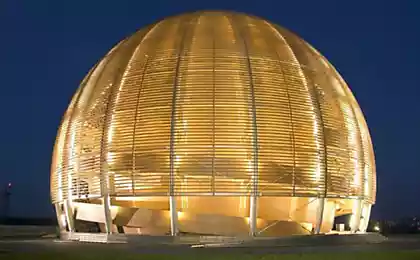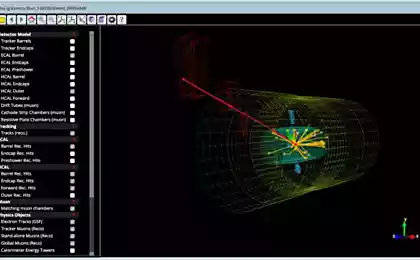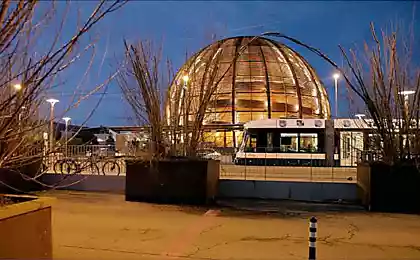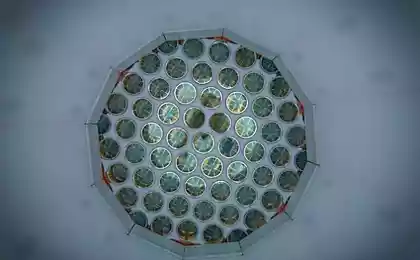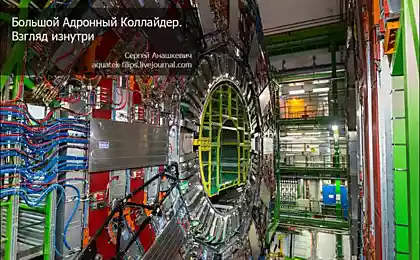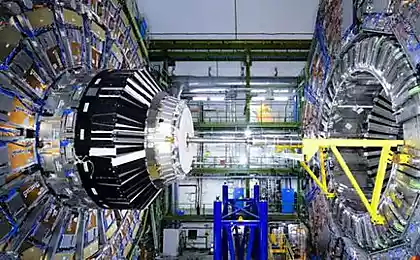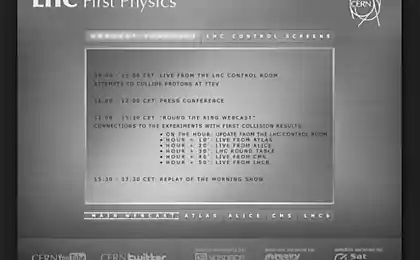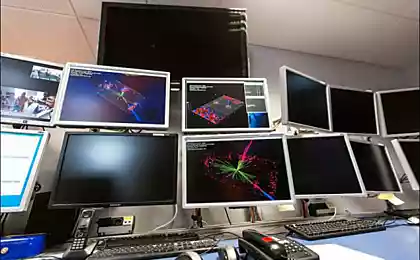1871
Yandex in new CERN experiment: how to find dark matter in just 13 years
Despite the fact that physicists sometimes try to present conservative, in fact, they are just waiting to find something that goes beyond the current understanding of nature. But they have such a long time did not work.
Once again, hope to update Standard Model collapsed after CERN found the Higgs boson. And despite the fact that, по According to Stephen Hawking , this discovery made physics boring problems that the Standard Model can not explain, still remain. One of them - what a particle may be a candidate for dark matter ? As you know, it is contained in the universe, but to see it we can not.
And now scientists at CERN are starting a new experiment - SHiP (Search for Hidden Particles). If these particles are discovered, then the Standard Model can be extended. This will mean that our understanding of the structure and evolution of the universe may change. And scientists may well qualify for a Nobel Prize. Conduct astrophysical research for space telescope will SHiP Astro-H . Yandex for this experiment not only provide its technology CERN machine learning: students and researchers of the School of data analysis Yandex will work together with its scientists.
Cooperation Yandex and CERN began in 2011, when we gave him his server. In 2012, we developed the to organize a search service, which was used in one of the four major experiments at CERN's Large Hadron LHC - Large Hadron Collider beauty experiment ( LHCb ). In 2013, physicists were able to use our own technology for machine learning - MatrixNet. Then Yandex became an associate member of the European Center for Nuclear Research in project CERN openlab .
http://video.yandex.ru/iframe/ya-events/7bxmn2ue74.5727/ video>
Two years ago, Yandex has performed Andrew Golutvin , scientific consultant director of CERN. It was exactly one day before it was officially announced the discovery of the Higgs boson. And last week at a special seminar Andrew spoke about the new experiment SHiP, which is already in the planning phase is supposed to use technology and knowledge Yandex. The lecture consists of five parts:
Once again, hope to update Standard Model collapsed after CERN found the Higgs boson. And despite the fact that, по According to Stephen Hawking , this discovery made physics boring problems that the Standard Model can not explain, still remain. One of them - what a particle may be a candidate for dark matter ? As you know, it is contained in the universe, but to see it we can not.
And now scientists at CERN are starting a new experiment - SHiP (Search for Hidden Particles). If these particles are discovered, then the Standard Model can be extended. This will mean that our understanding of the structure and evolution of the universe may change. And scientists may well qualify for a Nobel Prize. Conduct astrophysical research for space telescope will SHiP Astro-H . Yandex for this experiment not only provide its technology CERN machine learning: students and researchers of the School of data analysis Yandex will work together with its scientists.
Cooperation Yandex and CERN began in 2011, when we gave him his server. In 2012, we developed the to organize a search service, which was used in one of the four major experiments at CERN's Large Hadron LHC - Large Hadron Collider beauty experiment ( LHCb ). In 2013, physicists were able to use our own technology for machine learning - MatrixNet. Then Yandex became an associate member of the European Center for Nuclear Research in project CERN openlab .
http://video.yandex.ru/iframe/ya-events/7bxmn2ue74.5727/ video>
Two years ago, Yandex has performed Andrew Golutvin , scientific consultant director of CERN. It was exactly one day before it was officially announced the discovery of the Higgs boson. And last week at a special seminar Andrew spoke about the new experiment SHiP, which is already in the planning phase is supposed to use technology and knowledge Yandex. The lecture consists of five parts:
- Why do I need an experiment SHiP,
- the problem of the Standard Model,
- How does the detector and that it should be measured,
- is created as an international collaboration for creation and implementation of a large experiment,
- the main stages of the experiment,
- that collaboration SHiP expects Yandex.
Why do I need an experiment SHiP h4> Any experimental physicist tried in my life something open. And the idea of searching for particles of this sort is not new. You can see on this distribution results from many experiments that have already tried to find them. Generally, these results are presented as a two-dimensional distribution. On one axis is a quantity that characterizes the force with which these new particles interact with the known particles, and on another scale delayed mass of these particles. And here shows the result of a very large number of experiments that put quite impressive beyond the absence of such particles.
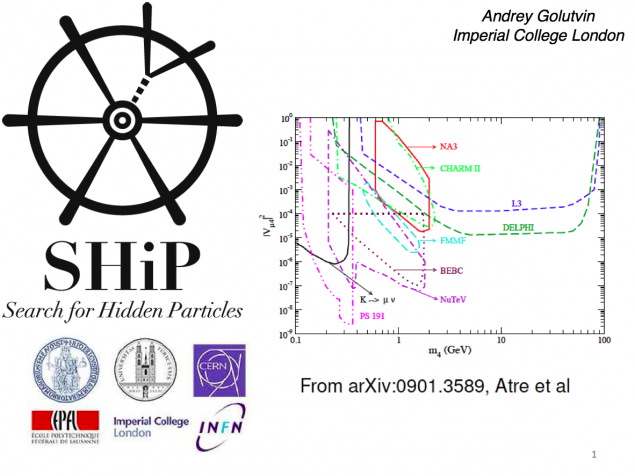
It was found that the standard model works very well and in fact describes all the phenomena in the microcosm, particle physics. And it turns out, this microcosm is not very complicated and, despite the huge number of different experimental particles. Of course, you've all heard about the protons , neutrons , electrons , muons . In fact, very little of the fundamental particles. This so-called fermions (only six known fundamental fermions leptons and six quarks ).
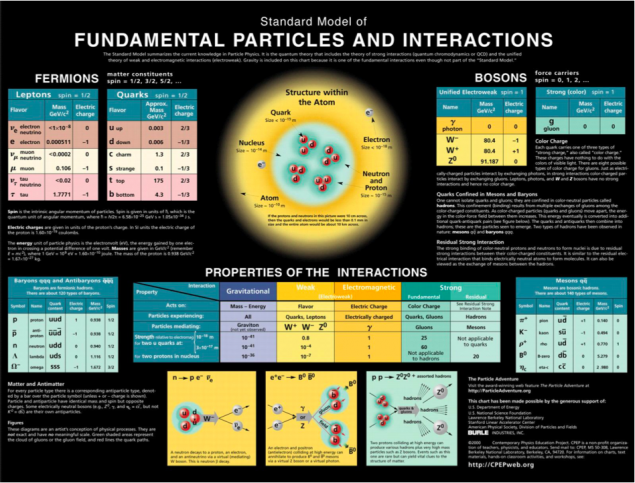
Of these quarks can construct all other mesons , which we know today. The interaction between these fundamental fermions are described by three forces:
- The electromagnetic interaction. Describes the interaction of charged particles.
- The weak interaction. They involve leptons (eg, neutrino , electrons, muons . But electrons and muons also participate in electromagnetic interactions, because they are - charged) quarks.
- Strong interactions. They involve quarks. They need to be able to create a proton and a neutron. tau lepton and three corresponding neutrinos . Neutrinos - a particle with a very small mass. They participate only in weak interactions, because neutrinos are electrically neutral.
And there are six quarks: up , down , charm , strange , top and bottom . It turns out that between the properties of leptons and quarks have much in common, and they say that there are three generations of leptons and quarks: the first, second and third. In fact, the properties of the electron and the neutrino, muon and neutrino properties, the properties of the tau lepton and tau neutrinos are absolutely the same. How do they differ? Only its mass. The mass of the muon is about 200 times larger than the electron, and tau-lepton mass 20 times greater than the mass of the muon. Why this is so, we do not know. The same thing happens with the quarks. Quarks are the first, second and third generation are absolutely the same properties - only different masses. And why their weight also quite different, we do not know.
Interactions that are experiencing these fundamental fermions, in particle physics to associate with native interactions. Electromagnetic interactions mediated by photons, the weak interaction - that these three bosons. Photon - massless, the mass of these bosons - about 100g GeV. Massless gluons carry the strong interactions.
Virtually all physical processes predicted standard model, were confirmed experimentally. The only bit that was missing, but it was predicted - the Higgs boson. The fact that the equations of the standard model have been written for massless particles, and then Higgs and several theorists have come up with a very elegant mechanism for how to use the Higgs boson make massive particles.
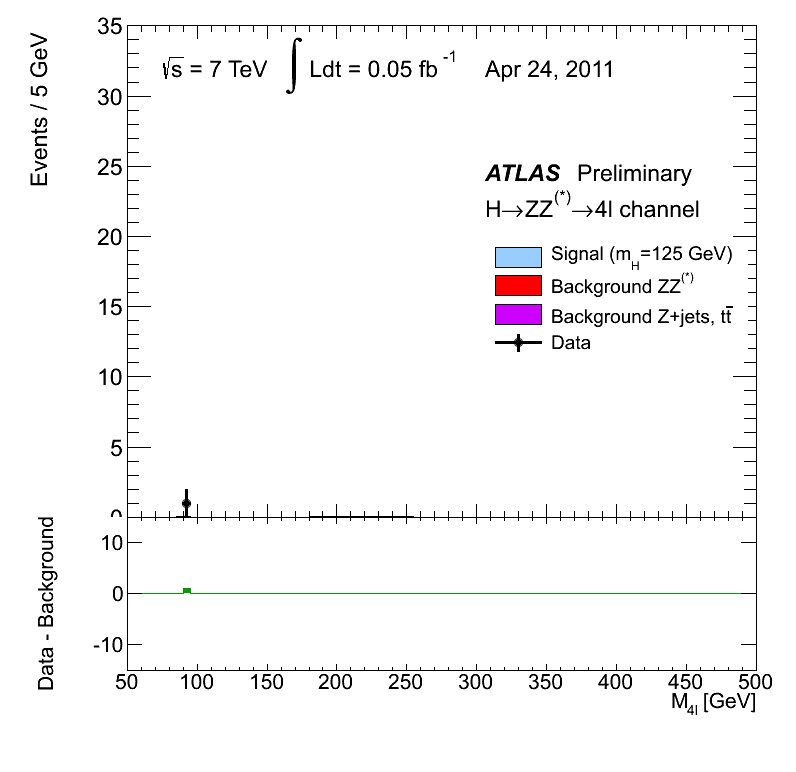
This is a very interesting distribution that shows the distribution of the mass of the Higgs boson - as it picks up during processing. And again no peak was seen. Today, we know that there is a Higgs boson, and its weight is equal here, and this peak is about 125 GeV. And today we can say for sure that these initial reports of mass of the Higgs were correct.
It turns out that this mass is very surprising. If the Higgs is in a very narrow mass range, it may be that, besides the standard model, nothing more and do not need that it can legitimately be classified as a complete quantum field theory, which runs up to the Planck scale, ie It describes all of the processes in the microcosm. Furthermore, with this Higgs mass can even describe the expansion of the universe without resorting to any other new particles.
Problems of the Standard Model h5> Nevertheless, physicists continue to look for what is called beyond standard model physics or new physics. Why do they do it? There are three major problems that the Standard Model does not explain.
The first problem is related to the experiments in microcosm. In the beginning it was thought that the three fundamental fermions massless. The Standard Model Higgs mechanism using can give mass to all other fermions and bosons, but not neutrinos. Today we absolutely know for sure that the neutrino has mass. We do not know what it is, but we do know that the three generations of neutrinos there is a difference in weight, and accurately measure the difference between the two masses of three generations of neutrinos. We need to come up with a mechanism of how to supplement the standard model so that the neutrino mass obtained. Given that, with what the Higgs boson mass found, the standard model claims to be a complete theory of quantum field. Do not want to change its equation, making up an additional mechanism of how to make massive neutrinos.
The second two major problems arise mainly from the very detailed research in cosmology and astronomy, which successfully passed the last 10-20 years. Today we know the existence of dark matter. The fact that the overwhelming gravitational mass of our universe does not absorb or emit light - it is invisible. At the same time we have a candidate for dark matter particles of known particles. Because dark matter can not be detected, its particles must be electrically neutral - otherwise we could see it on electromagnetic interactions, and it must interact very, very weak. In principle, the ordinary neutrinos could claim to be a candidate for dark matter, but we know that it is distributed in the universe is very uneven. Those heterogeneity that we observe in the universe, can be associated with very small irregularities in the first moments after the Big Bang. If dark matter consists of neutrinos, then due to the fact that the neutrino is very, very light, scattered particles have the same speed of light and no irregularities would not have arisen.
Perhaps a more complex explanation. We know about the places where the dark matter is concentrated. Using the language of classical physics, you can calculate the mass of the fermion. Remember that this particle, which must satisfy the Pauli principle - it is impossible at one point in space to have two odinkovye fermion. And you can calculate the mass of the fermion, so that the gravitational force, which tends to contract the clusters of dark matter, something to compensate. And she is compensated Fermi pressure. And here you can calculate a lower limit on the mass of the fermion. It should be of the order of 1 keV, which is many times greater than the mass of the neutrino. That is, the mass of the neutrino can not be dark matter, and therefore must be something else that would explain this huge cosmological effect.
And finally, the third biggest problem of the standard model. We know that when the accelerator is a collision, born about the same number of particles and antiparticles. This happened during the Big Bang. But there is a small symmetry breaking between the development in time of matter and antimatter. We are very well measured in its quarks. This well-known phenomenon for the study of which have been awarded two Nobel Prizes. The only problem is that the effect that we are seeing with neutral mesons in the quark sector, 10 10 sup> of times smaller than the mechanism that is needed to explain the absence of antimatter in the universe. But today we know that the lower limit on the admixture of antimatter in the universe is very, very small. There were even special experiments on space ships that tried to find traces of antimatter in the universe. In general, you should do something with these three problems.
Fundamental fermions, which are known to the standard model - the three generations of quarks, leptons, three generations, the interaction carriers and the Higgs boson.
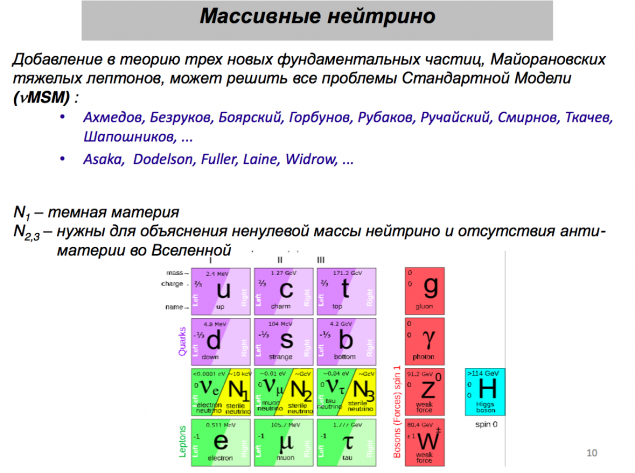
One of the very interesting things that can be done within SHiP, - try to find another three fundamental fermions, the so-called massive Majorana neutrino a >. They are marked on the scheme as N 1 sub>, N 2 sub>, N 3 sub>. And it turns out that by using these fundamental Majorana neutrinos can explain dark matter. The role of the candidate for dark matter would play N 1 sub>, the mass of which must be of the order of several keV. A heavier N 2 sub> and N 3 sub> is in the range from 0 to 5 GeV 40-50 GeV. And they can explain how to make an ordinary massive neutrinos, without violating the equation of the standard model, and greatly enhance the mechanism of symmetry breaking between matter and antimatter. In the creation of such a model, called the Neutrino Minimum Standard Model attended quite a number of Russian and physicists, and foreign scientists.
How will the detector is arranged and that it should be measured? H4> How to find them? To find N1, planned program of experiments in space. If you have N 1 sub> - a candidate for dark matter, and the mass of her rather large, several scheduled for 2015. Photon detector, which will be located on the Astro-H, has the desired resolution. Because dark matter surrounds us on all sides, it was perfect, so he settled on space satellites and could scan 4π - all areas of the universe. But usually, astrophysical experiments aimed at studying certain angular interval and aperture have very narrow. But three astromissy launch discussed at the 2019 -2020 year should be a much wider viewing angle.
To find particles N 2 sub> and N 3 sub>, we need experiments at accelerators. It is expected that the mass of these particles is in the area of 0, 5 GeV up to 30-40 GeV. Their search - this is one of the objectives of the experiment SHiP. Since the probability of occurrence of such particles - very, very rare process, you must ensure that the data array, where such particles can appear, too, was a very, very big. Where it can be obtained at accelerators TsERNa? This chain of accelerators that exists. Experiment SHiP proposed to conduct the accelerator .
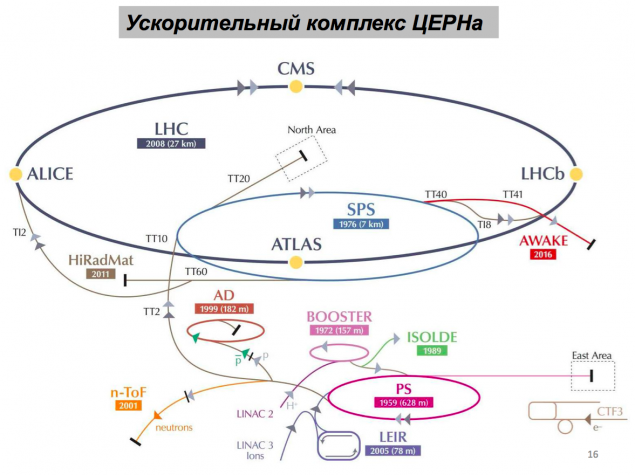
The fact that the lifetime of the proton beam in the Large Hadron Collider is about 20 hours. That is, after the injection of protons passed from SPS to the LHC, you roughly have 20 hours to use the proton-SPS accelerator for something else. In fact, until recently, these protons were used for birth ordinary neutrinos, and these neutrinos displayed here on this line and on to a special underground laboratory, which is located in Italy, at a distance of about 750 km from TsERNa. These experiments have been completed, and now really 70% of protons that can be used and which are produced in the accelerator SPS, free. And one of the motivations of the experiment SHiP - understand how to use these protons.
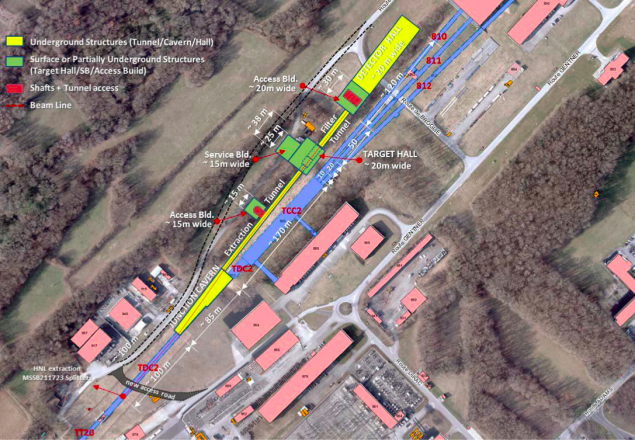
This is the place where you plan to experiment SHiP. It would require a rather expensive line of withdrawal of protons from SPS and quite a large hall (approximately 20x20 meters and a length of about 100 meters). Creating such additional infrastructure in order TsERNe worth 100-120 million Swiss francs. Who will be the first published study of engineering such a special beam line.
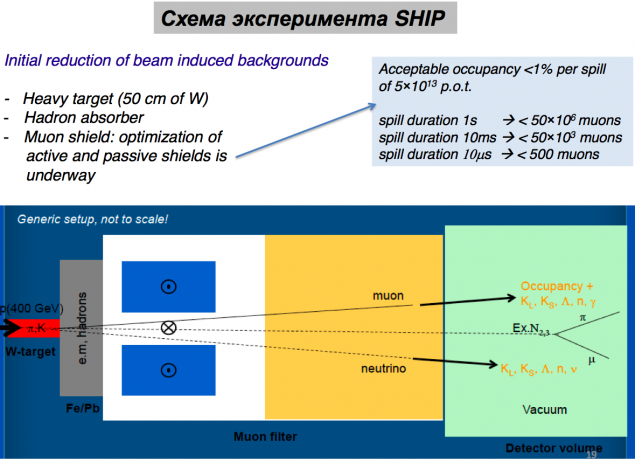
How should look experiment SHiP? For every second you can produce a clot 5x10 13 sup> of protons. And such a conclusion can be made every seven seconds. If the experiment in this fashion will work for 3-4 years, then you can dial in about 2x10 20 sup> proton interactions. They all need to analyze and find among them several signaling events. Look for these events will be in this experimental setup, but between the impact point of the target protons and the installation must be located special protection, which will absorb the unwanted particles to leave only those that interact very weakly and which will pass through this protection.
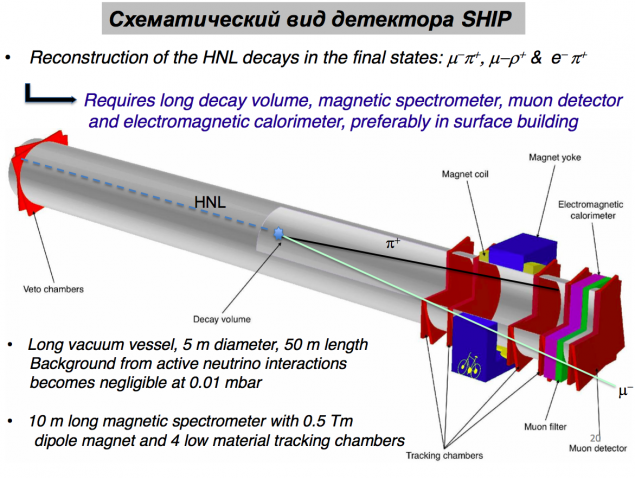
This is a very schematic view of this installation. Now that the planned length of the cylinder is approximately 50 meters in diameter - 5 meters.
Joint sports inspire!
Blacker than black, carbon nanotube coating formed from a record low reflectivity








